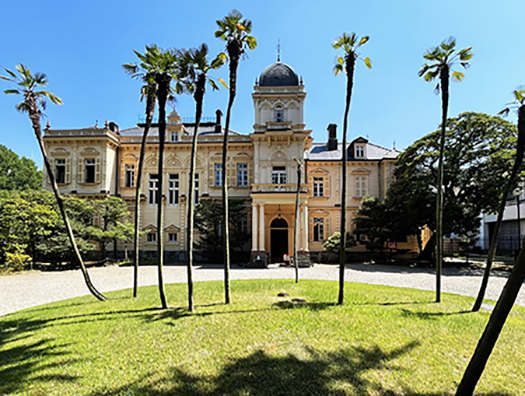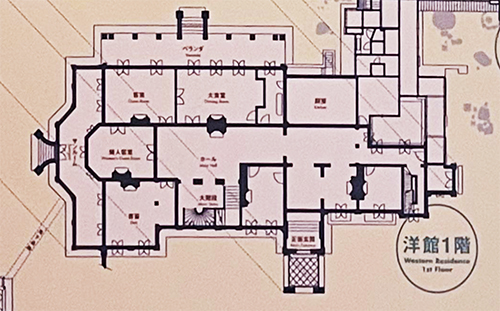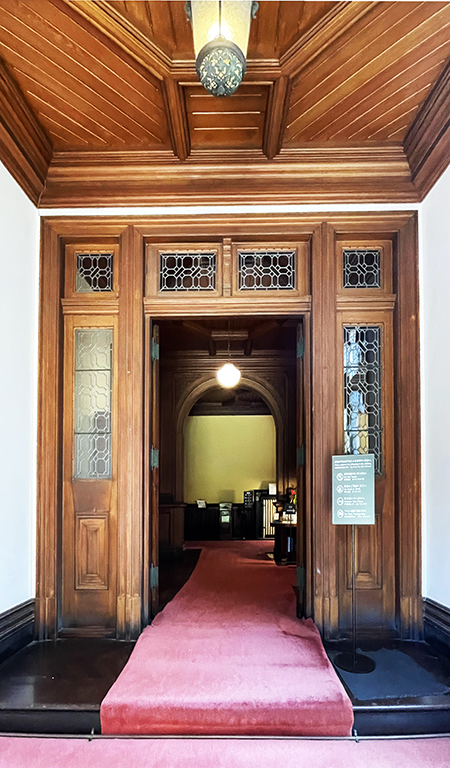
東京には半世紀前頃に(笑)、8年間いたのでそれなりの土地勘もあるのですが、案外上野周辺というのは馴染みがほとんどなかった。逆に最近東京出張すると必ず美術館巡りをしたいのでその行動拠点として上野というのは、東京国立博物館をはじめとして文化施設が集中していて、利便性が高い。
そういった土地勘からすると不忍池近くの高台にこの邸宅は望まれて、それが「旧岩崎邸」という三菱財閥の創始者の名が冠せられていることもあって、現在は国有資産で公園化していると言われても縁遠いと感じていた。70年安保闘争期の元新左翼少年としては「資本家」の象徴みたいに感じていたのかも知れません(笑)。
そもそも日本歴史好きだけれど、現代日本人特有な特性として近現代史については歴史授業でほとんど学ぶことがなくて基礎的な知識レベルが低い。戦後、現代史はなるべく触れないことにしようというオカシなコンセンサスが成立している。結果、東京都内という非常に街並み変化の激しい土地柄もあって、その直接的な来歴、歴史については断片的な情報に留まらざるを得ない。そういうこともあって他の地方と大きく違って、情報が少なく縁遠く感じてしまうのでしょう。また、首都地域であるので地域独自性というのも顕在化しにくい。
しかしそういうバイアスを消去してみると、この旧岩崎邸は大名屋敷の後継敷地・建築であることは容易に気付くことができる。
この上野不忍池周辺は江戸に入府した徳川家として、仮想敵勢力としての東北・伊達家、会津・上杉家地域などへの街道に面した要衝であり、最初にその防衛役を担ったのは、いまの大河ドラマで出てくる榊原康政だという。
その屋敷が置かれたのがこの敷地であり、やや高地に立地しているのは物見の用でもあったと推測できる。東京都内であるのに、上の写真では建物の背景にビル群の映り込みもないのは、立地適性を物語っている。
明治以降、東北本線の起点として上野が選択されたのには、当然ながらこういった要衝地であったことが反映したのでしょう。現代に至っても灯籠などに榊原家時代の痕跡が見られる、とも言われている。


現代に残されているこの明治29年建築という洋館は、岩崎家2代当主がイギリスの建築家ジョサイア・コンドルに依頼して建築させたもの。現在重要文化財指定。
コンドルは明治10年に工部大学校(現・東京大学工学部)の造家学(建築学)教師として来日して西洋建築学を教えた。傍ら明治期洋館の建築家として活躍し、上野博物館や鹿鳴館、有栖川宮邸などを設計。辰野金吾をはじめ創成期の日本人建築家を育成し、明治以後の日本建築界の基礎を築いた。<あしたへ続く>
English version⬇
Hatsugen is the residence of the four Tokugawa kings, Sakakibara.
A defense base against virtual enemies in the Tohoku region. On the hill adjacent to Shinobazuno Pond, a natural moat in the low marshy area of Ueno, Yasumasa Sakakibara, one of the Four Heavenly Kings of Tokugawa, had his residence and commanding presence. The city was also known as
I was in Tokyo for eight years around half a century ago (laugh), so I have a reasonable familiarity with the area, but surprisingly, I had little familiarity with the Ueno area. On the contrary, when I travel to Tokyo these days, I always want to visit art museums, so Ueno is a convenient base for such activities because of its concentration of cultural facilities, including the Tokyo National Museum.
As a former New Leftist boy during the 70-year Security Treaty struggle, I may have felt like a symbol of “capitalists” (laugh). As a former New Leftist boy during the 70’s Security Treaty struggle, I may have felt it was a symbol of “capitalists” (laugh).
Although I love Japanese history to begin with, modern and contemporary history is a characteristic of modern Japanese, and I rarely learn about it in history class, so my basic knowledge level is low. There is a strange consensus that postwar and contemporary history should be avoided as much as possible. As a result, due to the rapidly changing nature of the Tokyo metropolitan area, the direct history of the city is limited to fragmentary information. This is one of the reasons why, unlike other regions, there is very little information about the city and it seems remote from the rest of the country. In addition, because it is a metropolitan area, the uniqueness of the region is not readily apparent.
However, when such biases are eliminated, it is easy to realize that the former Iwasaki Residence is the successor site and architecture of a daimyo’s mansion.
The area around Ueno Shinobazunoike Pond was a strategic point for the Tokugawa family, which entered Edo, facing a road leading to the areas of the Date family in Tohoku and the Uesugi family in Aizu, which were the hypothetical enemy forces.
The first person to take charge of its defense was Yasumasa Sakakibara, whose residence was located on this site, and it can be assumed that the slightly elevated location was used as a place to view things. The fact that there is no reflection of buildings in the background of the building in the photo above, even though it is located in Tokyo, shows the suitability of the location.
The fact that Ueno was chosen as the starting point of the Tohoku Main Line after the Meiji era (1868-1912) must naturally reflect the fact that it was such a strategic location. It is said that traces of the Sakakibara family period can still be seen in the lanterns and other structures even today.
This Western-style house, built in 1896, was commissioned by the second head of the Iwasaki family to British architect Josiah Conder. It is currently designated as an Important Cultural Property.
Condor came to Japan in 1877 as a teacher of architecture at the School of Engineering at the University of Tokyo, where he taught Western architectural studies. He was also active as an architect of Western-style buildings during the Meiji period, designing the Ueno Museum, the Rokumeikan, the Arisugawa-no-miya Palace, and others. He fostered the development of Japanese architects such as Kingo Tatsuno, and laid the foundation of Japanese architecture after the Meiji era. .
Posted on 9月 4th, 2023 by 三木 奎吾
Filed under: 住宅マーケティング, 住宅取材&ウラ話







コメントを投稿
「※誹謗中傷や、悪意のある書き込み、営利目的などのコメントを防ぐために、投稿された全てのコメントは一時的に保留されますのでご了承ください。」
You must be logged in to post a comment.